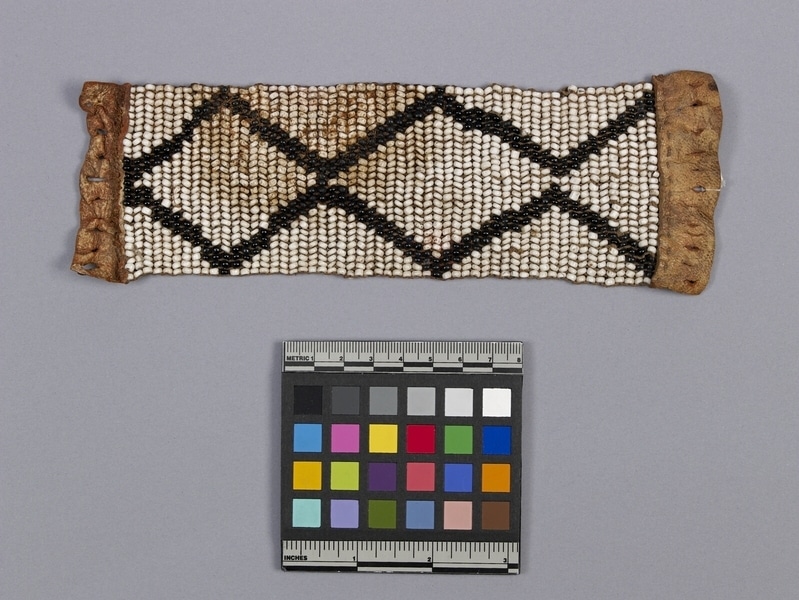Anklet Item Number: K5.47 from the MOA: University of British Columbia

Description
Skin band with beading on both sides. Black beaded geometric diamonds on white beaded background. Hide strips at both ends with holes perhaps for laces.
History Of Use
Anklet (isitsaba, plural izitsaba), South Nguni, worn by adolescent girls, unmarried women, and adult men for ceremonial occasions; would have had leather strips for fastening. During the time this anklet would have been made, glass beads were the principal unit of exchange between the Xhosa people and the British Fort Willshire on the Keiskamma River; following this they became an integral mode of Xhosa expression. Women would begin beadwork as children and would hone their skills by making items for themselves, or their family. As they matured, they would present beaded items, especially necklaces, to show affection for suitors. This isitsaba was likely a gift from a man's fiancee, sister, or mother.
Narrative
Collected by Captain E. M. Wilmot.
Iconographic Meaning
The pairing of the colours black and white in men’s beaded items commonly refers to their status as a newly-initiated man, called ikrwala. The zigzag design, which would have differed between the anklets on either leg, represents one of the many rivers in the Xhosa landscape.
Specific Techniques
Before the arrival of cotton or nylon fibre, threading among the Xhosa often relied on a particular type of aloe plant referred to as ikhala (A. arborescens). Once the fleshy parts of the plant are removed and it is thoroughly dried, it is possible to thread beads onto strips of sinew without the need for a needle. The beading process is called ukuhlahla.
Item History
- Made in South Africa between 1850 and 1900
- Collected between 1899 and 1902
- Owned by Edmond M. Wilmot
- Owned by Francis H. Wilmot before March 14, 1960
- Received from Francis H. Wilmot (Donor) on March 14, 1960
What
Who
- Culture
- Xhosa
- Previous Owner
- Edmond M. Wilmot and Francis H. Wilmot
- Received from
- Francis H. Wilmot (Donor)
Where
- Holding Institution
- MOA: University of British Columbia
- Made in
- South Africa
When
- Creation Date
- between 1850 and 1900
- Collection Date
- between 1899 and 1902
- Ownership Date
- before March 14, 1960
- Acquisition Date
- on March 14, 1960
Other
- Item Classes
- beadwork; textiles
- Condition
- fair
- Accession Number
- 0019/0020